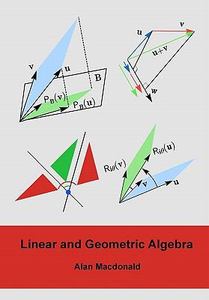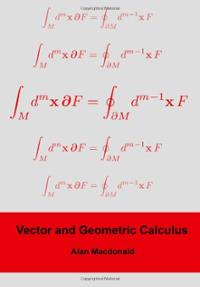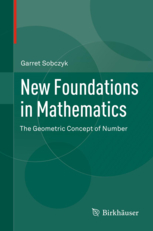For the last few years, I have been digging into and learning a new and fascinating field of mathematics.
Geometric algebra (and its offspring, geometric calculus) is a branch of mathematics which richly deserves to be better known. I do not say this simply because it is a piece of mathematics that is “neat” or “elegant” or held in high esteem in the mathematics community. Indeed, it seems less well-known in the mathematics world than it ought to be. I say this — that it deserves to be better known — for the following reasons:
1. It has lots of potential applications outside mathematics. For example, relativity theory, string theory, computer graphics, robot motion, electromagnetic theory, mechanics, etc.
2. It has the potential to unify within a single framework lots of pieces of mathematics that are usually presented as different “provinces” of mathland, each with its own machinery and language: For instance, complex analysis, differential geometry, differential forms, linear algebra, vector analysis, etc.
3. The basic ideas of geometric algebra (geometric calculus) can be presented starting from a basis of elementary linear algebra and the multivariable calculus one would pick up in an introductory calculus sequence. In other words, the machinery of geometric algebra is unusually ACCESIBLE; it does not require great sophistication. (At least to begin with.)
As if all that were not enough, the material also lends itself better than many portions of mathematics to drawing pictures and geometric intuition. Oh, and yes, it IS elegant, so I guess that’s taken care of as well.
WHAT IS IT LIKE? WHERE CAN WE SAMPLE THE BREW?
Geometric algebra can be thought of as part of what is known as Clifford algebras. (Geometric calculus is then Clifford analysis.) People who want know more about the history of these ideas started should look up Hermann Grassmann and William Kingdon Clifford.
Geometric algebra deals with objects called multivectors.
You may recall hearing vectors described as mathematical objects that have both a magnitude and a direction. Examples are a displacement (or translation) and a force. A displacement amounts to a move from one point to another; there is a direction in which one moves and a distance (magnitude) that one moves. A force (think of gravity, magnetism, a rocket thrust) has both a direction in which it is applied and a given strength (magnitude). Vectors are often represented in an introductory course as directed line segments; the direction of the line segment is the direction of the vector, and the length of the line segment gives the vector’s magnitude.
The term “multivector” includes vectors. But it also includes real numbers and and objects that are neither real numbers nor vectors in the sense of directed line segments. Perhaps the simplest of these new objects is a simple 2-vector ![]() . In this expression,
. In this expression, ![]() and
and ![]() are vectors and we think of
are vectors and we think of ![]() as being the oriented parallelogram having
as being the oriented parallelogram having ![]() and
and ![]() as edges. When we say the parallelogram is oriented, we mean that it is endowed with a sense of left-handedness or right-handedness. (This last remark may not be clear without actually delving into the math.) We may also talk about oriented simple 3-vectors
as edges. When we say the parallelogram is oriented, we mean that it is endowed with a sense of left-handedness or right-handedness. (This last remark may not be clear without actually delving into the math.) We may also talk about oriented simple 3-vectors ![]() , simple 4-vectors, etc. All of these objects can be added to one another and multiplied by scalars, just like ordinary vectors. However some of the multivectors will look strange since we may, in this setting add dissimilar expressions and wind up with things like
, simple 4-vectors, etc. All of these objects can be added to one another and multiplied by scalars, just like ordinary vectors. However some of the multivectors will look strange since we may, in this setting add dissimilar expressions and wind up with things like ![]() where
where ![]() is a scalar (real number) and
is a scalar (real number) and ![]() is a vector.
is a vector.
In summary then, multivectors — the objects of a geometric algebra — are linear combinations of simple ![]() -vectors, while the simple
-vectors, while the simple ![]() -vectors are objects that have “direction” (in the sense of lying in a
-vectors are objects that have “direction” (in the sense of lying in a ![]() -dimensional subspace), “magnitude” (length, area,
-dimensional subspace), “magnitude” (length, area, ![]() -dimensional volume), and “orientation” (a sense of “right-handedness” or “left-handedness”) and can be pictured as
-dimensional volume), and “orientation” (a sense of “right-handedness” or “left-handedness”) and can be pictured as ![]() -dimensional analogs of parallelograms. What makes the multivectors so powerful is the operations one can carry out with them. We have, of course, addition and multiplication by scalars, but we have also a dot or inner product (several versions!), the wedge product (denoted
-dimensional analogs of parallelograms. What makes the multivectors so powerful is the operations one can carry out with them. We have, of course, addition and multiplication by scalars, but we have also a dot or inner product (several versions!), the wedge product (denoted ![]() , a generalization of the vector product
, a generalization of the vector product ![]() ), and the grandest operation of all, the geometric product (denoted plainly and simply
), and the grandest operation of all, the geometric product (denoted plainly and simply ![]() ). The geometric product is intimately linked with the wedge product and the dot product and can be used to define them. This connection is hinted at by the fact that for ordinary vectors
). The geometric product is intimately linked with the wedge product and the dot product and can be used to define them. This connection is hinted at by the fact that for ordinary vectors ![]() in
in ![]() we have
we have
![]()
Furthermore, the geometric product offers the amazing ability to divide by vectors and even by nonzero simple ![]() -vectors, an operation which connects very naturally with the construction of orthogonal complements of vector subspaces.
-vectors, an operation which connects very naturally with the construction of orthogonal complements of vector subspaces.
This machinery can be applied to calculus on curved surfaces (manifolds). There are intuitive ways to define orientation and induced orientation on surfaces and their boundaries. The theory of differential forms turns out to be a piece of this more general theory. The fundamental theorem of calculus can be generalized to geometric calculus and has the standard theorems of vector analysis (such as Gauss’s divergence theorem) and the generalized Stokes theorem as special cases.
Probably the best known source for material on geometric algebra, geometric calculus is Clifford Algebra to Geometric Calculus by David Hestenes and Garret Sobczyk. And Hestenes has written a Tutorial on Geometric Calculus which gives an overview of the field.
However for the beginner or someone who just wants a quick dip in the water, a better place to start might be Alan Macdonald’s A Survey of Geometric Algebra and Geometric Calculus. This is a short and accessible introduction to the field. Macdonald also two books available, Linear and Geometric Algebra and Vector and Geometric Calculus, which are aimed at students on roughly the sophmore level. Links to these works and a number of other papers on geometric algebra and geometric calculus can be found at Alan Macdonald’s webpage at Luther College. 

There is a website Geometric Calculus Research & Development that is devoted to the work of David Hestenes. Hestenes must be viewed as the moving spirit behind the development and promotion of geometric algebra and calculus over a long span of years. For his overview of the field, see his Oersted Medal Lecture of 2002: Reforming the Mathematical Language of Physics.
One may also wish to consult Garret Sobczyk’s homepage. Sobczyk has just come out with an introductory book to this field titled New Foundations in Mathematics, The Geometric Concept of Number. 
If you’re interested in physics, there is Geometric Algebra for Physicists by Doran and Lasenby.  And for computer scientists there is Geometric Algebra for Computer Science by Dorst, Fontijne, and Mann.
And for computer scientists there is Geometric Algebra for Computer Science by Dorst, Fontijne, and Mann.  But the person who wants to delve more deeply into the mathematical theory will find the articles in Lectures on Clifford (Geometric) Algebras and Applications by Ablamowicz and Sobczyk very useful.
But the person who wants to delve more deeply into the mathematical theory will find the articles in Lectures on Clifford (Geometric) Algebras and Applications by Ablamowicz and Sobczyk very useful. 
I